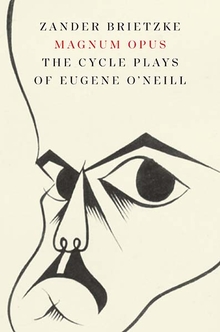Big Work
Zander Brietzke—
On January 1, 1935 Eugene O’Neill outlined a series of four plays about four brothers (a ship captain, a gambler, a politician, and a railroad magnate) set in the second half of the nineteenth century. O’Neill called this group his Cycle because each play was to circulate the overall theme: the corrosive effects of greed and materialism upon the human soul. He quickly added another play about how the parents of the boys met (A Touch of the Poet), and then another about their marriage (More Stately Mansions). Then, he decided that he could use the idea for an unfinished play from the previous decade, originally called “It Cannot Be Mad,” as the seventh and final play that would bring the story up to time in which he wrote and cover the years between 1900 and 1932.
O’Neill wanted the Cycle to surpass all his previous works in size and scope. The Freudianism in the nine-act Strange Interlude (1928) was a huge popular success on stage and in print. Mourning Becomes Electra (1931) retold the Oresteia in the post-Civil War days, replaced the gods with psychology as part of a modern trilogy, and helped O’Neill win the Nobel Prize. “It Cannot Be Mad” was to have been the third part of another trilogy that included the Broadway failures Dynamo (1929) and Days Without End (1934). These three plays, O’Neill elaborated in a 1928 letter to George Jean Nathan, were “to dig at the roots of the sickness of Today as I feel it—the death of the old God and the failure of Science and Materialism to give any satisfying new one for the surviving primitive religious instinct to find a meaning for life in, and to comfort its fears of death with. It seems to me anyone trying to do big work nowadays must have this big subject behind all the little subjects of his plays or novels, or he is simply scribbling around on the surface of things and has no more real status than a parlor entertainer.” O’Neill wanted to do what had never been done in American drama.
The Cycle grew in his imagination from the story of four brothers to all of American history through the lives of seven generations of a single family. Having brought the Cycle up to the present day, O’Neill continued to expand his project by focusing first on the grandmother of the boys, and then their great aunts. He traced the family back as far as 1755 with two double-length plays. He also came up with an ending. He changed the title of the last play from “It Cannot Be Mad” to “The Hair of the Dog” and gave the youngest of the brothers, now one hundred years old, the final lines: “We have been bitten by 111 dogs—and they’re all the same dog, and his name is the Greed of the Living and when he bites you there’s a fever comes and a great thirst and a great drinking to kill it, and a grand drunk, and a terrible hangover and headache and remorse of conscience—and a sick empty stomach without greed or appetite. But take a hair of the dog and the sun will rise again for you—and the appetite and thirst will come back, and you can forget—and begin all over!” The speech proved prophetic for a nation on the brink of world war in June 1939.
O’Neill was never content with the drafts of the two extra-long plays on the front end of the Cycle. He took another look in 1940 and decided to exchange them for four normal-length plays. The Cycle now stood at eleven plays. But O’Neill never wrote so much as a draft of any of the four new plays. And, although the project had started with four brothers, he never actually drafted any of those plays. He wrote the final speech for “The Hair of the Dog,” but he never wrote that play, either. He did write about the boys’ parents. He completed three consecutive drafts of More Stately Mansions and four drafts of A Touch of the Poet. He spent over half his working days on the Cycle on these two plays, numbers five and six, in the middle of the whole thing. Combined, these two plays are the Cycle.
What remains is still huge—and a complete story. O’Neill revised A Touch of the Poet to fit perfectly as the prequel to More Stately Mansions and detail the history of the family. The latter play is longer than the combined length of The Iceman Cometh and Long Day’s Journey Into Night. It needs cutting, but it forecasts the future and the tragic outcomes for the four sons. The two plays have never been staged together, but if they were it would be an epic event akin to Kushner’s Millennium Approaches and Perestroika. O’Neill eventually called his Cycle “A Tale of Possessors Self-Dispossessed.” If the two plays were presented as one today, they might speak to our greedy times of capitalism run amuck. To riff on the end of Angels in America, it’s time for this great work to begin.
Zander Brietzke is the author of The Aesthetics of Failure, American Drama in the Age of Film, and Action and Consequence in Ibsen, Chekhov and Strindberg. A former president of the Eugene O’Neill Society, he taught modern and contemporary drama at Columbia University.
Further Reading:



























